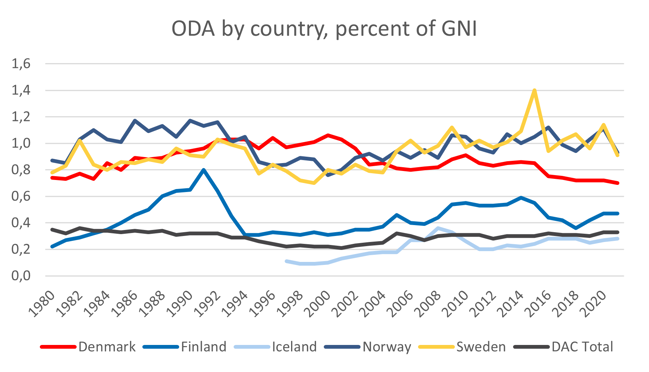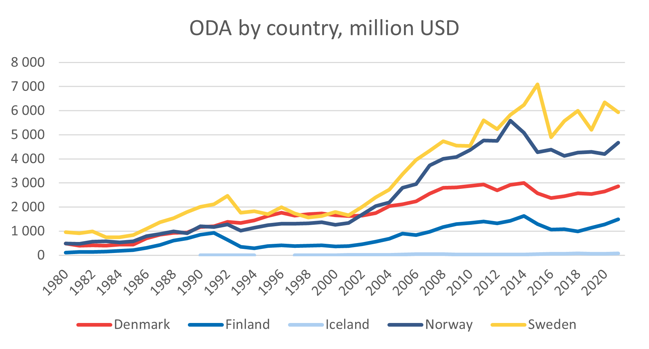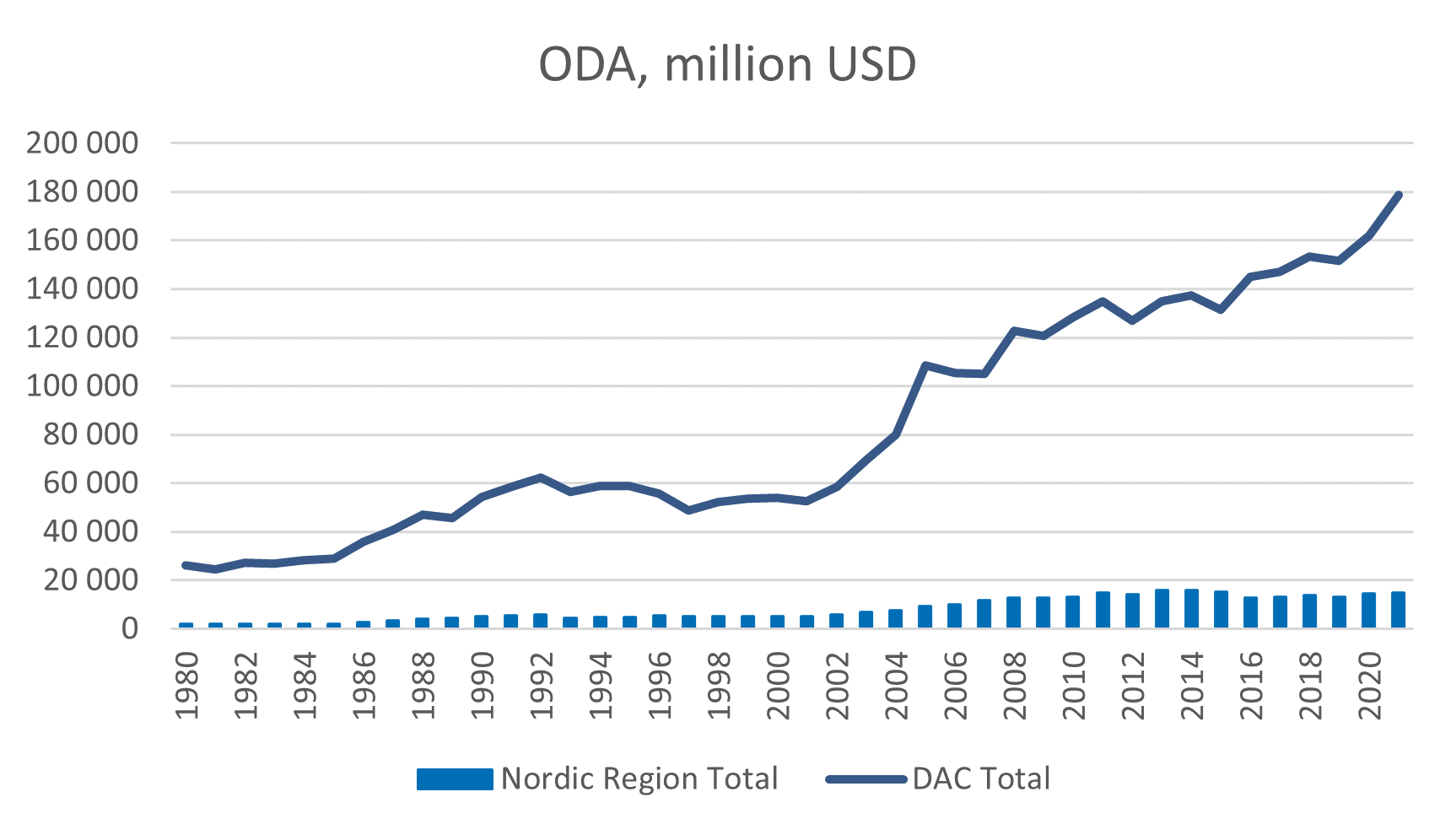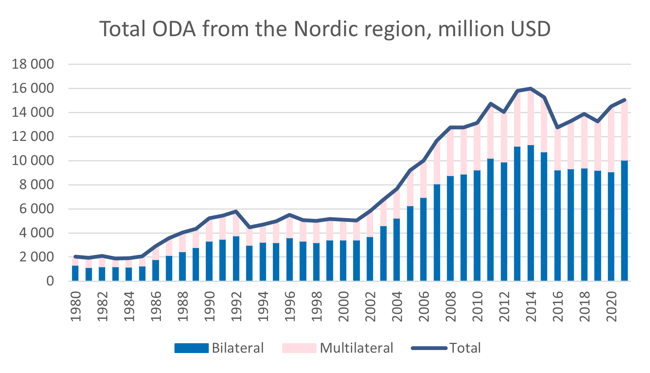Five countries met the UN target of official development assistance in 2021, three of them are Nordic
Five DAC members, of which three are Nordic countries, met or exceeded the 0.7% target in 2021 – Denmark, Germany, Luxembourg, Norway and Sweden. [1]
The 2021 ODA total is equivalent to 0.33% of DAC donors combined gross national income (GNI), unchanged from 2020 and still below the UN target of 0.7 % ODA to GNI. Fluctuations in countries’ GNI levels due to the COVID-19 crisis will have affected the trend in that ratio since 2020. [2] Five DAC members – Denmark (0.7%), Germany (0.7%), Luxembourg (1.0%), Norway (0,9%) and Sweden (0.9%) – met or exceeded the 0.7% target in 2021. Even though not reaching the target of 0.7%, Iceland (0.3%) is close to the DAC average and Finland (0.5%) has been above the average for practically the whole time period.
Source: Nordic Statistics Database, OFDE02: Government aid to developing countries, million US$ and percent of GNI, by reporting country, flow and time
In 2021, Official Development Assistance (ODA) provided by the Nordic countries amounted to USD 15 billion. The total, provided by all members of the OECD’s Development Assistance Committee (DAC), reached an all-time high of USD 179 billion. In relation to the DAC donors combined gross national income (GNI), the 2021 ODA total is however unchanged from 2020. It amounted to 0.33%, still failing to meet the UN target of 0.7% ODA to GNI.
Measured in USD, Sweden has been the largest contributor of ODA during practically the whole time period since 1980. Norway and Denmark took turns at being second largest contributor up until 2002, when Norway started to increase their aid at a higher pace than Denmark. In 2021, Sweden provided USD 5.9 billion, Norway USD 4.7 billion, Denmark USD 2.9 billion, Finland USD 1.5 billion and Iceland USD 71 million. For all countries except Sweden this is more than in 2020.

Source: Nordic Statistics Database, OFDE02: Government aid to developing countries, million US$ and percent of GNI, by reporting country, flow and time
Official development assistance (ODA), a category used by the Development Assistance Committee (DAC) of the Organisation for Economic Co-operation and Development (OECD), is a widely used indicator of international aid flow. It reflects material resources provided by governments of wealthy countries to promote the economic development of developing countries and the welfare of their people. The donor government agency may disburse such resources directly to the government of the recipient country (bilateral ODA) or through mediating organizations (multilateral ODA).
Foreign aid from official donors was USD 179 billion in 2021. In the Nordic region the equivalent was USD 15 billion USD, which constitutes 8% of the total ODA. The share of total ODA provided by the Nordic region has varied between 7 and 12% since 1980.
Source Nordic Region Total: Nordic Statistics Database, OFDE02: Government aid to developing countries, million US$ and percent of GNI, by reporting country, flow and time
Source DAC Total: OECD Database, DAC1: Total flows by donor
The ODA from the DAC countries has increased substantially since 1980, especially since the beginning of the new millennia. The ODA provided by the five Nordic countries has also increased at a similar pace. Although, the ODA provided by the five Nordic countries was higher in the years between 2013 and 2015 than in 2021. Most ODA is bilateral, in the Nordic region as well as at a total level. This means that the aid is provided directly to a recipient and that the state donor is identifiable at the point of delivery. Multilateral ODA refers to aid that is given into a pool administered by an intermediate organisation, so that the delivered aid is no longer attributable to a particular original state donor at the point of delivery.

Source: Nordic Statistics Database, OFDE02: Government aid to developing countries, million US$ and percent of GNI, by reporting country, flow and time
[1] In November 2022 DAC had 31 members, including the five Nordic countries. Observers include The United Nations Development Programme, the International Monetary Fund and the World Bank. Faroe Islands, Greenland and Åland are not members, so no data is available for them.
[2] https://www.oecd.org/dac/covid-19-assistance-to-developing-countries-lifts-foreign-aid-in-2021-oecd.htm